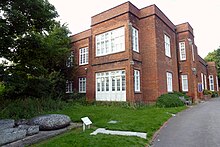Saffron Walden Museum
The Saffron Walden Museum is a museum on Museum Street in Saffron Walden , Essex .
History and Buildings
The museum opened in 1835. It's in a small park next to Walden Castle , which dates back to the 12th century. An extension to include a “Heritage Quest Center” is planned; this facility is scheduled to open in 2012. The main building has two floors and looks rather sober from the outside. Saffron Walden Museum is one of the oldest museums in the country, built for this purpose from the start. At the entrance there is a one-storey former school building from 1817, which is now used as a training room, conservation laboratory and warehouse. A few kilometers from the actual museum there is a branch that is not generally accessible to visitors, but is open to those interested in science. Larger exhibits and reserve collections are kept here. This building represents an emergency solution that became necessary after the actual storage rooms had been cleared in 1984/85.
In addition to the permanent presentation, the museum also regularly shows special exhibitions.
The founder of the museum was the Saffron Walden Natural History Society, which had set itself the task of showing the art, craft and way of life of the various peoples as well as awakening a sense of the beauties of nature in the visitors. She was supported by a number of rich Quaker families in the area, including the Gibson, Tuke and Fry families. The museum's first professional curator was hired in 1880. George Nathan Maynard was later succeeded by his son Guy, who then became director of the Ipswich Museum . The collections are still owned by the society, now called the Saffron Walden Museum Society. Since 1974 the museum has been administered by the Uttlesford District Council.
The Saffron Walden Museum is open 363 days a year and is visited by around 20,000 people each year. It is barrier-free and has a small museum shop.
Collections
In the Saffron Walden Museum you can see exhibits on the natural history of Northwestern Sex, but also objects from more distant areas. Only a small part of the more than 175,000 items in the collection can be presented to the public.
In the archaeological section , finds are shown, some of which date from prehistoric times. Exhibits from Northwest Sex illustrate life in this area from the Ice Age to the Middle Ages . Stone and bronze tools are represented here as well as exhibits on life in the Iron Age and in the Roman provincial town of Chesterford . There is also a section on Egypt and the Eastern Mediterranean. On display are Greek and Cypriot vessels as well as the sarcophagus of the priest Tayef-Herut-Nakht from the 10th century BC. An Egyptian boy and a cat mummy can also be seen.
The ceramics and glass collection mainly focuses on English and European products, whereas the travelers, missionaries, soldiers and colonial masters brought a wide variety of objects from foreign countries. The Saffron Walden Museum owns items of clothing, instruments and cult objects from several continents.
In addition to human-made exhibits, minerals and fossils are also presented, including ichthyosaur bones . The natural science department shows extensive collections of plant and animal preparations. The historical herbarium includes more than 14,000 dried plant parts. Some of them were brought together by collectors such as George Stacey Gibson , Joshua Clarke , WLP Garnons and Frederick Brocas . Most of the animal preparations also date from the 19th century. People like Joseph and Joshua Clarke, Jabez Gibson , John Gould and Stephen Salmon were collectors and taxidermists. The bird egg collection comes in part from WM Tuke and HE Smith. The bone collection owes a number of exhibits to Edward Tuck .
Special exhibits
A necklace from the time of the Vikings was featured on the BBC series A History of the World . It comes from a woman's grave from around 875 to 900 AD and was made of glass, silver, carnelian and crystal and is decorated with the symbol of the cross. The jewelry was unearthed from the Gibson family's property at Hill House in 1876. This area was a cemetery in the late Saxon period. As was customary with Christians at this time, the remaining dead were buried without grave goods; the grave from which the jewelry was made was an exception. A piece of the skin of the elephant Chunee is also kept in the Saffron Walden Museum.
A well-known specimen in the museum is the Wallace lion. Wallace was born in Edinburgh in 1812 . He was the first African lion to be born in England and was named after William Wallace . It belonged to the menagerie owner George Wombwell , who gave it to the museum after his death in 1838. During his lifetime, Wallace had inspired the writer Marriott Edgar , whose Albert poems were read by Stanley Holloway , to write the ballad "The Lion and Albert". The prepared lion is one of the most popular exhibits among visitors.
Web links
Individual evidence
- ↑ http://www.bbc.co.uk/ahistoryoftheworld/objects/s8TO6bKbRUyC9cdNTge6BA
- ↑ http://www.abdn.ac.uk/~nhi708/treasures/wombwellstiger.php
- ↑ Archived copy ( memento of the original from February 21, 2015 in the Internet Archive ) Info: The archive link was inserted automatically and has not yet been checked. Please check the original and archive link according to the instructions and then remove this notice.
Coordinates: 52 ° 1 ′ 31.1 ″ N , 0 ° 14 ′ 30.3 ″ E


